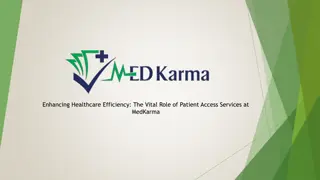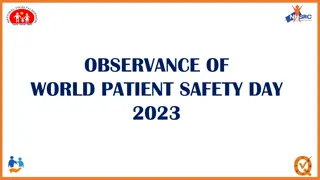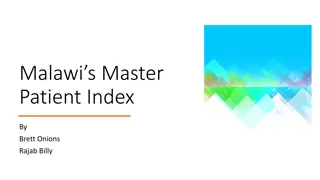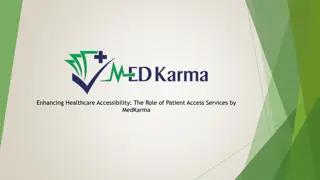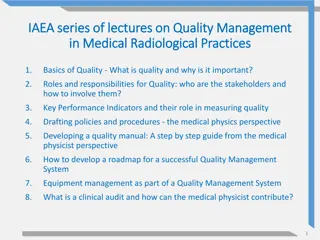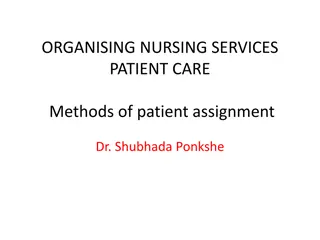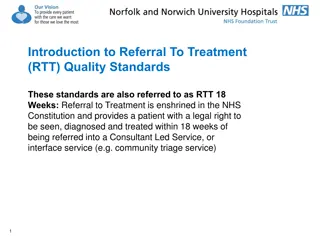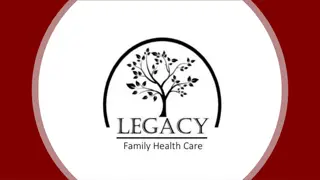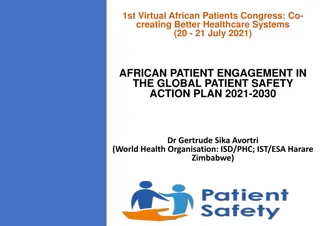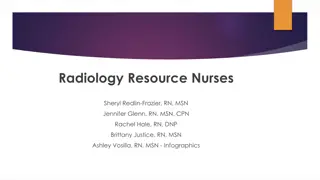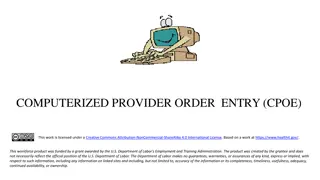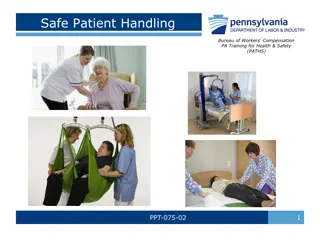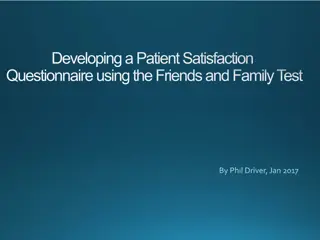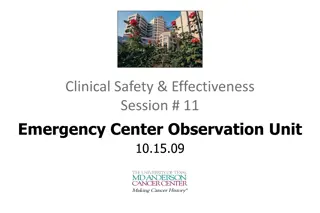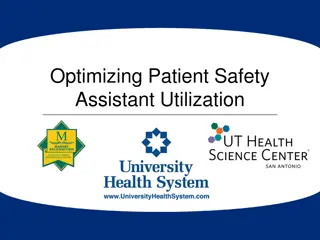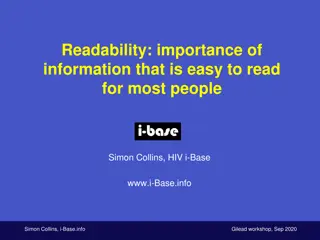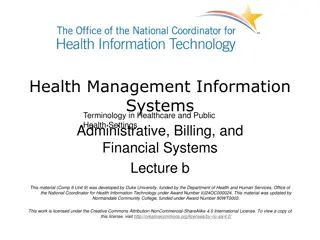Key Dimensions of Patient Safety and Healthcare Quality
Understanding the importance of patient safety in healthcare settings is critical. This content covers defining patient safety, the distinction between error and harm, various aspects of patient safety culture, and the role of physicians. Real-world scenarios and specific behaviors for fostering a safe environment are highlighted. Explore the significance of reducing unnecessary harm and the staggering impact of medical errors on patient outcomes. Discover the magnitude of patient safety issues and learn how to promote a culture of safety in the workplace.
Download Presentation

Please find below an Image/Link to download the presentation.
The content on the website is provided AS IS for your information and personal use only. It may not be sold, licensed, or shared on other websites without obtaining consent from the author.If you encounter any issues during the download, it is possible that the publisher has removed the file from their server.
You are allowed to download the files provided on this website for personal or commercial use, subject to the condition that they are used lawfully. All files are the property of their respective owners.
The content on the website is provided AS IS for your information and personal use only. It may not be sold, licensed, or shared on other websites without obtaining consent from the author.
E N D
Presentation Transcript
1 Patients Safety PREPARED BY : MR. MAHER TITI MRS. NADA ALHABIB MR. ALAA ABU ALRUB QUALITY MANAGEMENT DEPARTMENT
Outline 2 Introduction and defining patient safety The key dimensions of healthcare quality Harm Versus error Sources of System Error Patient safety culture Types of clinical incident Seven levels of safety The physician s role in patient safety Case scenario
Objectives 3 After completing this lecture you should: Recognize the magnitude and the importance of patient safety Define and describe the key elements of healthcare quality Summarize the differences between error and harm Recognizing characteristics of a just culture Differentiate between the different types of clinical incidence Describe several specific behaviors you can practice to foster a culture of safety in your workplace
Defining patient safety-Video 4 https://www.youtube.com/watch?v=BJP2rvBchnE
Defining patient safety 5 The reduction of risk of unnecessary harm associated with health care to an acceptable minimum. (WHO, World Alliance for Patient Safety 2009).
Introduction 6 Significant numbers of patients are harmed due to their health care, either resulting in permanent injury, increased length of stay (LOS) in health-care facilities, or even death. 44 98,000 deaths annually caused by medical error. There are more deaths annually as a result of health care than from road accidents, breast cancer and AIDS combined. Recent financial estimates suggest that adverse events cost the Uk 2 billion in 2000 in extra hospital days alone. Other costs, such as suffering of patients, their families and the health care workers involved, are incalculable.
Introduction Video 7 https://www.youtube.com/watch?v=BJP2rvBchnE
Why is it a problem? 8 Years in which data was collected Number of hospital admissions Number of adverse event Adverse event rate (%) Hospital/Country US(Harvard Medical Practice Study) Australian (Quality in Australian healthcare study ) UK Denmark KKUH 1984 30195 1133 3.8 1992 14179 2353 16.6 1999-2000 1998 2014 1014 1097 47211 119 176 2950 11.7 9 6.2 Source: World Health Organization. Executive board 109th session, provisional agenda item3,4,5, 2001,EB 109/9
The 6 key dimensions of healthcare quality 9 Safe: Avoiding injuries to patients from the care that is intended to help them. Effective: Providing services based on scientific knowledge to all who could benefit and refraining from providing services to those not likely to benefit (avoiding underuse and overuse). Doing the right thing for the right person at the right time.
The 6 key dimensions of healthcare quality 10 Timely: Reducing waits and sometimes unfavorable delays for both those who receive and those who give care. Family-centered: Providing care that is respectful of and responsive to individual patient preferences, needs and values, and ensuring that patient values guide all clinical decisions.
The 6 key dimensions of healthcare quality 11 Efficient: Avoiding waste, in particular waste of equipment, supplies, ideas and energy. Equal: Providing care that does not vary in quality because of personal characteristics such as gender, ethnicity, geographic location and socio- economic status
Harm VS Error 12 Error An error is a failure to carry out a planned action as intended. Errors may manifest by doing the wrong thing (commission) or by failing to do the right thing (omission). Harm Impairment of structure or function of the body and/or any deleterious effect arising from interaction with health care. Harm includes disease, injury, suffering, disability and death. Example : A patient with breast cancer undergoes chemotherapy. The treatment causes severe nausea and vomiting (a known complication) and she is admitted with clinical dehydration. Example, a patient with shortness of breath is diagnosed with pneumonia and treated with an antibiotic. A few days later she is admitted as her condition worsens. Subsequent investigations reveal a pulmonary embolism as the true problem. This is treated with anticoagulation.
Sources of System Error 13 All errors can be divided into two main groups: Active errors or human error are committed by frontline staff and tend to have direct patient consequences. Latent or system errors are those errors that occur due to a set of external forces and indirect failures involving management, protocols/ processes, organizational culture, transfer of knowledge, and external factors Example, giving the wrong medication, treating the wrong patient or the wrong anatomical site, or not following the correct policies and procedures. Example : understaffed wards or inadequate equipment.
Error in medicine 14 Errors in health care can be caused by active failures or latent conditions. Most errors are not a result of personal error or negligence, but arise from system flaws or organizational failures
"Swiss cheese" model of accident causation 15
"Swiss cheese" model of accident causation 16 The systems have many holes: some from active failures and others from latent conditions. These holes are continuously opening, shutting, and shifting their location. In any one slice, they do not normally cause harm, because the other intact slices prevent hazards from reaching the potential victim. Only when the holes in many layers momentarily line up does the trajectory of accident opportunity reach the victim causing the damage
Definition of patient safety culture 17 An integrated pattern of individual and organizational behavior, based on a system of shared beliefs and values, that continuously seeks to minimize patient harm that may result from the process of care delivery.
Patient safety culture 18 Previously, in many cases the traditional response to adverse incidents in health care has been to blame, shame and punish individuals. The opposite of a blame culture is a blame-free culture, which is equally inappropriate. In some instances, the responsible individual should be held accountable.(in case of negligence or recklessness) Recently , the a just culture has been adapted which means : balancing the blame and no blame approaches
Patient safety culture 19 Example If a patient is found to have received the wrong medication and suffered a subsequent allergic reaction, Blame culture: we look for the individual student, pharmacist, nurse or doctor who ordered, dispensed or administered the wrong drug and blame that person for the patient s condition care at the time of the incident and hold them accountable Just Culture: we look for the system defect such as communication , protocols and processes for medication management , in addition to investigate the negligence or recklessness of the worker
20 Living a Just Culture Video https://www.youtube.com/watch?v=yWhb4vLIegM
The concept of Clinical incident: 21 Definition: A clinical incident is an event or circumstance resulting from health care which could have, or did lead to unintended harm to a person, loss or damage, and/or a complaint. (deviation from standard of care and safety ) Examples: Medication errors (e.G. Wrong medication, omission, overdose); Patient falls; Intended self harm or suicidal behaviour; Therapeutic equipment failure; Contaminated food; Problems with blood products; Documentation errors; Delayed diagnosis; Surgical operation complications; Hospital acquired infection;
Types of Clinical incident 22 Clinical Incidence Adverse Event Near Miss Sentinel Event/Never Event Adverse Drug reaction
Types of Clinical incident 23 Adverse Event: An adverse event is an unintended injury or complication which results in disability, death or prolonged hospital stay, and is caused by health- care management Example : Medication errors
Types of Clinical incident 24 Sentinel events: A sentinel event is an unexpected occurrence involving death or serious physical or psychological injury, or the risk thereof. Serious includes loss of limb or function. Example: Hemolytic transfusion reaction involving administration of blood or blood products having major blood group incompatibilities injury specifically
Types of Clinical incident 25 Never Events: Events should never happen while in a hospital, and can be prevented in most cases. Example: Infant discharged to the wrong person Wrong surgical procedure performed on a Patient Patient death or serious disability associated with a medication error
Types of Clinical incident 26 Near miss: Is any situations that did not cause harm to patients (that did not reach the patient) , but could have done.
Types of Clinical incident 27 Adverse drug reaction: A response to a drug which is noxious and unintended, and which normally used in man for the prophylaxis, diagnosis, or therapy of disease, or for the modifications of physiological function'.( WHO,1972) occurs at doses
Seven levels of safety 28 Patient factors: such as personality, language and psychological problems may also be important as they can influence communication with staff. Task factors: The design of the task, the availability and utility of protocols . Individual factors: include the knowledge, skills and experience of each member of staff
Seven levels of safety 29 Team factors: The way an individual practices, and their impact on the patient, is influenced by other members of the team and the way they communicate and support each other. Working conditions: These include the physical environment, availability of equipment and supplies and the light, heat, interruptions and distractions that staff endure.
Seven levels of safety 30 Organizational factors: The team is influenced in turn by management actions and by decisions made at a higher level in the organization. These include policies, continuing education, training and supervision and the availability of equipment and supplies. External environment factors: The organization itself is affected by financial constraints, external regulatory bodies and the broader economic and political climate.
The physicians role in patient safety 31 Standardization, such as the use of order sets, protocols, and reminders. Designing safe systems and implementation of technology. use smart intravenous pumps that detect medication errors, barcoding to ensure the five rights of medication administration (right patient, right route, right dose, right time, right medication).
The physicians role in patient safety 32 Teamwork Communication: poor communication can delay diagnosis, create confusion regarding the plan of care, and increase the cost of care through repeated tests. Lack of effective communication creates frustration with patients and families and increases their anxiety
The physicians role in patient safety 33 Involve yourself in measuring, monitoring, and improving quality. Avoid blaming when an error occurs. Practice evidence-based care. Detect adverse events: report and Disclose errors to patients and their families.
The physicians role in patient safety 34 Adhere and follow the National Patient Safety Goals/ ROP(Required Organization Practice ) Adverse reporting Hand hygiene Client verification Antibiotic prophylaxis during surgery Medication reconciliation Falls prevention strategy Dangerous abbreviations Pressure ulcer prevention Transfer of client information at transition points Venous thromboembolism prophylaxis Control of concentrated electrolytes Safe injection practices Infusion pumps training Safe surgical practices High-alert medications Preventive maintenance program
Video 35 https://www.youtube.com/watch?v=BFd54Yzg-vo
Case Study 1 Recommended actions: 37 Pharmacists / Technician should READ / CHECK carefully the label of each medication they prepare. DOUBLE CHECKING is essential tool to avoid such mistakes Look Alike medications should be stored separately with proper labeling to avoid such mistakes To change the brand the hospital purchases of either drugs if possible
Case Study - 2 A 38-year-old woman comes to the hospital with 20 minutes of itchy red rash and facial swelling; she has a history of serious allergic reactions A nurse draws up 10 mls of 1:10,000 adrenaline (epinephrine) into a 10 ml syringe and leaves it at the bedside ready to use (1 mg in total) just in case the doctor requests it Meanwhile the doctor inserts an intravenous cannula The doctor sees the 10 ml syringe of clear fluid that the nurse has drawn up and assumes it is normal saline
Continue. case study - 2 There is no communication between the doctor and the nurse at this time The doctor gives all 10 mls of adrenaline (epinephrine)through the intravenous cannula thinking he is using saline to flush the line. The patient suddenly feels terrible, anxious, becomes tachycardia and then becomes unconscious with no pulse She is discovered to be in ventricular tachycardia, is resuscitated and fortunately makes a good recovery Recommended dose of adrenaline (epinephrine) in anaphylaxis is 0.3 - 0.5 mg IM, this patient received 1mg IV
40 Can you identify the contributing factors for this error?
Can you identify the contributing factors to this error? Lack of communication Inadequate labeling of syringe Giving a substance without checking and double checking what it is Lack of care with a potent medication
How could this error have been prevented?
How could this error have been prevented? Never give a medication unless you are sure you know what it is; be suspicious of unlabeled syringes Never use an unlabeled syringe unless you have drawn the medication up yourself Label all syringes Communication - nurse and doctor to keep each other informed of what they are doing e.g. nurse: I m drawing up some adrenaline Develop checking habits before administering every medication go through the 5 Rse.g doctor: What is in this syringe?
Conclusion 44 Patient safety is the avoidance, prevention and amelioration of harm from healthcare. Two approaches to the problem of human fallibility exist: The person approach focuses on the errors of individuals, blaming them The system approach concentrates on the conditions under which individuals work Some errors cause harm but many do not. Blaming and then punishing individuals is not an effective approach for improving safety within the system Adverse events often occur because of system breakdowns Standardizing and simplifying clinical processes is a powerful way of improving patient safety
Bibliography 45 Maamoun J,An Introduction to Patient Safety. Journal of Medical Imaging and Radiation Sciences 40 (2009) 123-133 Reason J.Human error: models and management. BMJ. 2000 Mar 18;320(7237):768-70. Sutker WLThe physician's role in patient safety: What's in it for me?. Proc (Bayl Univ Med Cent).2008 Jan;21(1):9-14. Sutker WL. The physician's role in patient safety: What's in it for me? Proc (Bayl Univ Med Cent). 2008 Jan;21(1):9-14 Goode LD1, Clancy CM, Kimball HR, Meyer G, Eisenberg JM. When is "good enough"? The role and responsibility of physicians to improve patient safety. Acad Med. 2002 Oct;77(10):947-52.
46 Thank you



